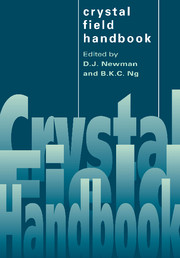Book contents
- Frontmatter
- Contents
- List of contributors
- Preface
- Introduction
- 1 Crystal field splitting mechanisms
- 2 Empirical crystal fields
- 3 Fitting crystal field parameters
- 4 Lanthanide and actinide optical spectra
- 5 Superposition model
- 6 Effects of electron correlation on crystal field splittings
- 7 Ground state splittings in S-state ions
- 8 Invariants and moments
- 9 Semiclassical model
- 10 Transition intensities
- Appendix 1 Point symmetry
- Appendix 2 QBASIC programs
- Appendix 3 Accessible program packages
- Appendix 4 Computer package CST
- Bibliography
- Index
10 - Transition intensities
Published online by Cambridge University Press: 10 December 2009
- Frontmatter
- Contents
- List of contributors
- Preface
- Introduction
- 1 Crystal field splitting mechanisms
- 2 Empirical crystal fields
- 3 Fitting crystal field parameters
- 4 Lanthanide and actinide optical spectra
- 5 Superposition model
- 6 Effects of electron correlation on crystal field splittings
- 7 Ground state splittings in S-state ions
- 8 Invariants and moments
- 9 Semiclassical model
- 10 Transition intensities
- Appendix 1 Point symmetry
- Appendix 2 QBASIC programs
- Appendix 3 Accessible program packages
- Appendix 4 Computer package CST
- Bibliography
- Index
Summary
The intensities of transitions within the 4fN configurations of lanthanide ions are strongly dependent on the environment of the ion. The electric dipole transitions that dominate the solid state and solution spectra are forbidden for an isolated ion. They only become allowed when the symmetry is reduced from the full rotational symmetry of a free ion to the point group symmetry at an ion in a condensed matter environment.
The phenomenological and ab initio descriptions of lanthanide intensities are much less developed than the description of crystal field split energy levels. This is due to various technical problems, both experimental and theoretical, that will be alluded to in this chapter. As a result, the detailed fitting of transitions between crystal field split levels is still relatively uncommon, over 35 years since it became possible.
The methods described here are relevant to the sharp line spectra of lanthanide and actinide ions in crystals, though the examples refer mostly to lanthanides. A detailed analysis of the broadband spectra typical of transition metal systems generally requires the addition of extra theoretical machinery to take account of vibronic progressions, Franck–Condon factors, etc. Analyses of the intense 4fN ↔ 4fN−15d transitions of lanthanide ions also require extensions.
The history of the field, particularly that of fitting total transition intensities between J multiplets, has been covered in a number of reviews [Pea75, Hüf78, GWB98].
- Type
- Chapter
- Information
- Crystal Field Handbook , pp. 190 - 226Publisher: Cambridge University PressPrint publication year: 2000
- 8
- Cited by

